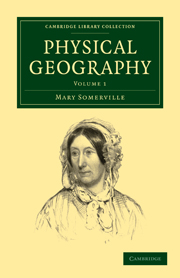Summary
Some thinner portion of the crust of the globe under the meridians that traverse the continent of America from Cape Horn to the Arctic Ocean must have yielded to the expansive forces of the subterranean fires, or been rent by the contraction of the strata in cooling. Through this the Andes had arisen, producing the greatest influence on the form of the continent, and the peculiar simplicity that prevails in its principal mountain systems, which, with very few exceptions, have a general tendency from north to south. The continent is 9000 miles long, and, its form' being two great peninsulas joined by a long narrow isthmus, it is divided by nature into the three parts of South, Central, and North America; yet these three are connected by the mighty chain of the Andes, but little inferior in height to the Himalaya, running along the coast of the Pacific from within the Arctic nearly to the Antarctic circle. In this course every variety of climate is to be met with, from the rigour of polar congelation to the scorching heat of the torrid zone; while the mountains are so high that the same extremes of heat and cold may be experienced in the journey of a few hours from the burning plains of Peru to the snowclad peaks above. In this long chain there are three distinct varieties of character, nearly, though not entirely, corresponding to the three natural divisions of the continent.
- Type
- Chapter
- Information
- Physical Geography , pp. 123 - 143Publisher: Cambridge University PressPrint publication year: 2009First published in: 1848



